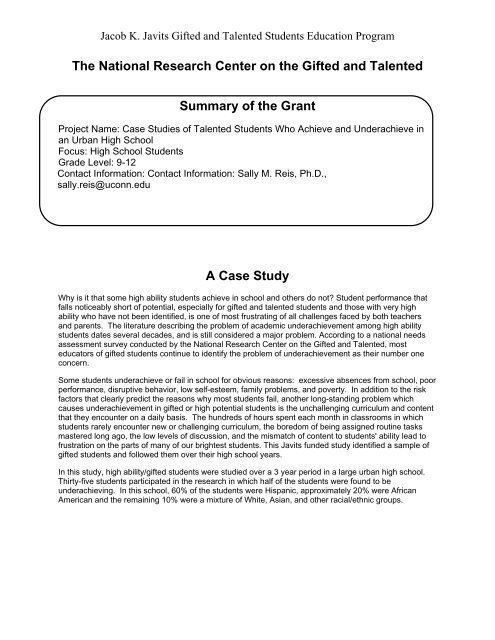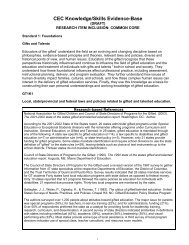Advanced Readers At Risk: Rescuing an Underserved ... - NAGC
Advanced Readers At Risk: Rescuing an Underserved ... - NAGC
Advanced Readers At Risk: Rescuing an Underserved ... - NAGC
Create successful ePaper yourself
Turn your PDF publications into a flip-book with our unique Google optimized e-Paper software.
Jacob K. Javits Gifted <strong>an</strong>d Talented Students Education Program<br />
The National Research Center on the Gifted <strong>an</strong>d Talented<br />
Summary of the Gr<strong>an</strong>t<br />
Project Name: Case Studies of Talented Students Who Achieve <strong>an</strong>d Underachieve in<br />
<strong>an</strong> Urb<strong>an</strong> High School<br />
Focus: High School Students<br />
Grade Level: 9-12<br />
Contact Information: Contact Information: Sally M. Reis, Ph.D.,<br />
sally.reis@uconn.edu<br />
A Case Study<br />
Why is it that some high ability students achieve in school <strong>an</strong>d others do not? Student perform<strong>an</strong>ce that<br />
falls noticeably short of potential, especially for gifted <strong>an</strong>d talented students <strong>an</strong>d those with very high<br />
ability who have not been identified, is one of most frustrating of all challenges faced by both teachers<br />
<strong>an</strong>d parents. The literature describing the problem of academic underachievement among high ability<br />
students dates several decades, <strong>an</strong>d is still considered a major problem. According to a national needs<br />
assessment survey conducted by the National Research Center on the Gifted <strong>an</strong>d Talented, most<br />
educators of gifted students continue to identify the problem of underachievement as their number one<br />
concern.<br />
Some students underachieve or fail in school for obvious reasons: excessive absences from school, poor<br />
perform<strong>an</strong>ce, disruptive behavior, low self-esteem, family problems, <strong>an</strong>d poverty. In addition to the risk<br />
factors that clearly predict the reasons why most students fail, <strong>an</strong>other long-st<strong>an</strong>ding problem which<br />
causes underachievement in gifted or high potential students is the unchallenging curriculum <strong>an</strong>d content<br />
that they encounter on a daily basis. The hundreds of hours spent each month in classrooms in which<br />
students rarely encounter new or challenging curriculum, the boredom of being assigned routine tasks<br />
mastered long ago, the low levels of discussion, <strong>an</strong>d the mismatch of content to students' ability lead to<br />
frustration on the parts of m<strong>an</strong>y of our brightest students. This Javits funded study identified a sample of<br />
gifted students <strong>an</strong>d followed them over their high school years.<br />
In this study, high ability/gifted students were studied over a 3 year period in a large urb<strong>an</strong> high school.<br />
Thirty-five students participated in the research in which half of the students were found to be<br />
underachieving. In this school, 60% of the students were Hisp<strong>an</strong>ic, approximately 20% were Afric<strong>an</strong><br />
Americ<strong>an</strong> <strong>an</strong>d the remaining 10% were a mixture of White, Asi<strong>an</strong>, <strong>an</strong>d other racial/ethnic groups.

















